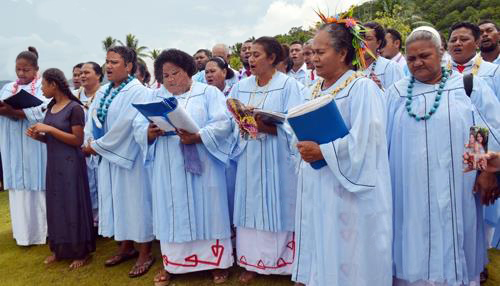The inhabitants of Kioa island in the province of Cakaudrove celebrated their 10th anniversary of arriving on the island with “happiness and thanksgiving” in 1957.
The event was marked by “boisterous jubilation, meke and dances”, in memory of the first immigrants, totalling 37 people, who arrived there from Vaitupu, in the Ellice Islands on October 26, 1947.
The 1957 celebrations commenced early in the morning and went into the night, ending at 11.30pm to allow villagers to have voice left for Sunday’s thanksgiving church service.
District Officer, E.A.Jones, in his capacity as adviser to the islanders, was present during the 10th anniversary celebrations, but because of other commitments on Taveuni, his visit was cut short.
Speaking through an interpreter, Mr Jones complimented the islanders for their “courage and tenacity” to start a new life on an uninhabited island “in a strange land whose language they did not know” in search of “happiness and prosperity”.
According to The Fiji Times of November 8, 1957, the people of Kioa arrived “with very little of this world’s goods”.
“It is understood that all they brought with them was 15 pounds worth of food to last them for over a few days,” the paper noted.
“Their fares were paid for by the Vaitupu community who had purchased the lovely island of Kioa for their surplus population. It had no buildings or houses.”
The village site of Salia was once occupied by the original inhabitants of Kioa Island from Cakaudrove, until the island was sold to a European to cover a debt.
The village site had a white sandy beach, a deep anchorage up to the shore, and a picturesque fringe of coconut trees along a horse-shoe bay.
“Snuggled in among these palm trees may be seen the many houses since erected, Fijian style, but all with raised wooden or bamboo floors,” The Fiji Times reported in November 1957.
The centre of the village had a village hall that doubled as a church.
It also had a store, believed to have been opened with a stock of 300 pounds.
Within a year that original stock ran dry.
A boat was also purchased with money from Vaitupu and was remodelled by Kioa islanders for better sea transport service.
In the 1950s, the people of Kioa used to produce 12 tonnes worth of copra in one year.
Of the original 37 immigrants who arrived in 1947, by 1957 seven men and four women, with their children, grew tired of the life on Kioa and returned to Vaitupu.
In 1957, 20 people had died and were buried on Kioa while births were around 40 to 50.
Additional immigration between 1947 and 1957 made population numbers rise to about 200 within 10 years.
According to Wikipedia, the Gilbert and Ellice Islands were a British protectorate from 1892 and colony from 1916 until January 1, 1976, when the islands were divided into two colonies which became independent nations shortly after.
A referendum was held in December 1974 to determine whether the Gilbert Islands and Ellice Islands should each have their own administration.
As a consequence of the referendum, the Gilbert and Ellice Islands colony ceased to exist on January 1, 1976 and the separate countries of Kiribati (descendants now live on Rabi Island) and Tuvalu (descendants now live on Kioa) came into existence.




